Western music is usually built around major, minor and harmonic minor scales. Other scales and modes we use in western music are usually derived from those scales in some shape or form. However in other places around the world they often build their music around other scales. Often they use different exotic instruments that don’t conform to a fixed twelve note chromatic scale.
Here we’re going to introduce some of these exotic scales, and how they can be played on your guitar.
Because these scales can be very different from the standard major and minor scales we are used to, it can be difficult to form chords from them. Or at least chords we’re used to. From the ‘How to make leads fit’ lesson, we know that in order to make playing a scale fit over chords, those chords need to only include notes from that scale. Have a look through the lesson if you’ve not yet.
This can cause a problem with many of these exotic scales. Since you’ll find often you won’t have the notes available to construct the standard westernised chords you are used too. This is to be expected since these scales sound very different.
So what chords should we play?
You’re going to have to be a bit creative in this department. With each scale we’re going to introduce, we’re going to show you a full fret board diagram up to the 12th fret. To keep things simple we’re going to show each scale in the key of A. Red dots on the diagrams show the A root note. Black dots show the other notes from the scale.
So using these diagrams you can also not only see what notes and positions you can play the scale, but also to build chords. Just look at the diagram and see if you can find any chord shapes that you can play using the dots as guides. They may be shapes and chords you’ve never played before, and we may not know the names of them, but at least we know they will match the scale.
One last thing before we dive in, in some cases we may not even need to play these scales over chords. Many traditional music from around the world is made from a collection of melodies and percussion, and don’t even use chords. So don’t feel like you really need to come up with really funky and odd chords.
Hirajoshi scale
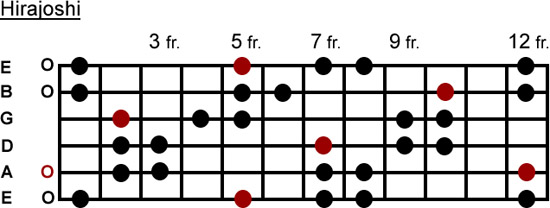
This is the Hirajoshi scale. In the key of A, it is made from these notes,
A B C E F
That’s a,
Root – major 2nd – minor 3rd – 5th – minor 6th
From these notes and the diagram we can see we can make a A minor and G minor chord. Can you spot any others? There are a few power chords we can make also. Hirojoshi has a eastern Japanese flavour.
Kumoi scale
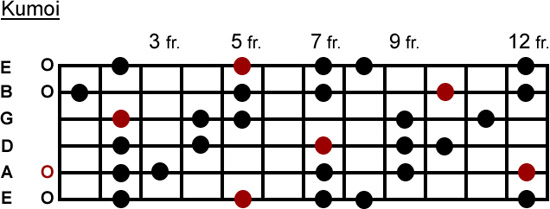
In the Key of A, the Kumoi scale is made from these notes,
A B C E F#
That’s a,
Root – major 2nd – minor 3rd – 5th – major 6th
We can make a A minor chord and a G minor, there are a few power chords we can construct also. Kumoi is another Japanese flavoured scale.
Chinese scale
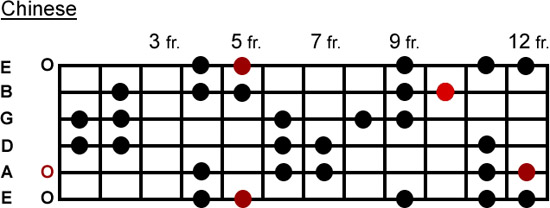
The Chinese scale, in the key of A is made from these notes,
A C# D# E G#
That’s a,
Root – major 3rd – Augmented 4th – 5th – major 7th
From the notes and the diagram, we can see a A major chord and a C# minor. We can also spot a number of power chords. As you can imagine, the Chinese scale sounds Chinese!
Egyptian scale

In the key of A, the Egyptian scale has these notes,
A B D E G
That’s a,
Root – major 2nd – 4th – 5th – minor 7th
We can spot a number of power chords we could play. Including an A, E, G and D. Egyptian scale as you can guess, sounds Egyptian!
Hungarian Gypsy scale

In the key of A, the Hungarian Gypsy scale is made from these notes,
A Bb C# E F#
That’s a,
Root – minor 2nd – major 3rd – 5th – major 6th
We can spot a A major chord and a F# major chord. We will need to improvise some new shapes if we want many other chords. As you’d guess from the name, this scale has a gypsy sound.
Romanian scale
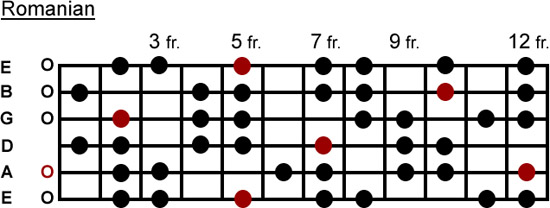
In the key of A, the Romanian scale is made from these notes,
A B C D# E F# G
That’s a,
Root – major 2nd – minor 3rd – augmented 4th – 5th – major 6th – minor 7th
We can spot a A minor chord, A diminished chord, B major, C major and E minor. We can also see a Am7. Romanian scale predictably sounds Romanian.
Persian scale
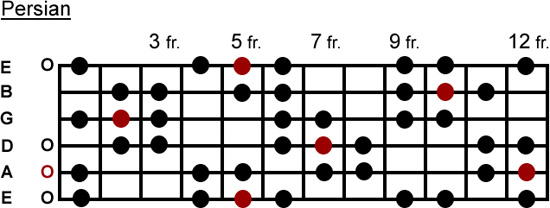
In the key of A,
A Bb C# D E F G#
That’s a,
Root – minor 2nd – major 3rd – 4th – 5th – minor 6th – major 7th
We can see a A major chord, Bb major and minor and a C# major and minor. The Persian scale has a middle eastern flavour.
Neopolitan minor scale
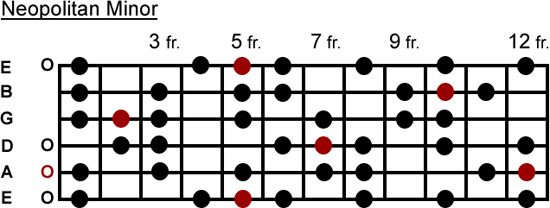
In the key of A,
A Bb C D E F G#
That’s a,
Root – minor 2nd – minor 3rd – 4th – 5th – minor 6th – major 7th
We can spot a A minor chord, Bb major, D minor and F minor and major. The Neopolitan minor scale has a Italian flavour.
Neopolitan major scale
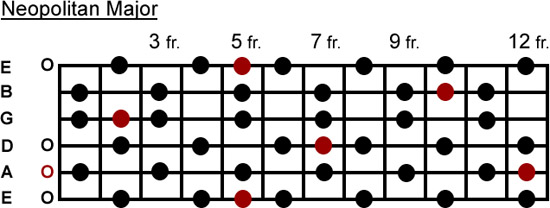
In the key of A,
A Bb C# D# E F G
That’s a,
Root – minor 2nd – minor 3rd – 4th – 5th – major 6th – major 7th
We can see a A minor chord and D major. Like the Neopolitan minor, the Neopolitan major scale also has a Italian sound.
Prometheus scale
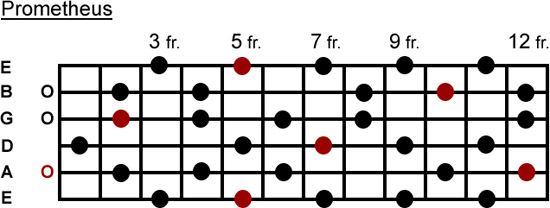
In the key of A,
A B C# D# G
That’s a,
Root – major 2nd – major 3rd – diminished 5th – minor 7th
We’ll have to be creative and try out some new unusual chord shapes if we want to make chords from this scale. The Prometheus scale has a Greek sound. This scale odd, in that it contains no semitone gaps.
Ritusen scale
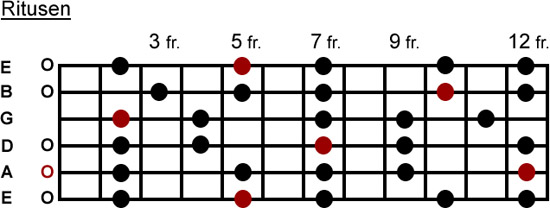
In the key of A,
A B D E F#
That’s a,
Root – major 2nd – 4th – 5th – major 6th
The Ritusen scale is a odd scale in that it doesn’t contain any semitone gaps. We can see an A power chord, B minor, D major and an E power chord. The Ritusen scale has a eastern Asian sound.
Arabian scale
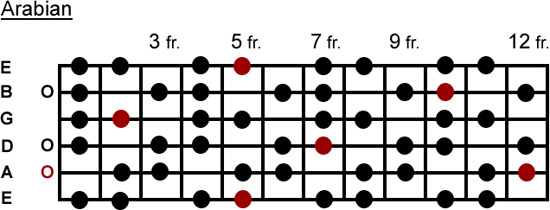
The Arabian scale in the key of A,
A B C D Eb F Gb Ab
That’s a,
Root – major 2nd – minor 3rd – 4th – diminished 5th – minor 6th – major 6th – major 7th
We can see a A diminished, B major chord, D major and a F major and minor.
You may decide not to learn any exotic scales and stick with the standard western conventions. And there is nothing wrong with that, if you like the sound of something stick with it. If however you find a exotic scale you find pleasing, experiment with it and explore it further. It can really add another dimension to your music and set you apart from the crowd!
Key points to remember!
- Use full neck diagrams to spot which chords can be played with these scales.
- Music from around the world may not conform to our understanding of western music rules.
- These scales are rarely used in western music, dont feel pressured to learn them .
